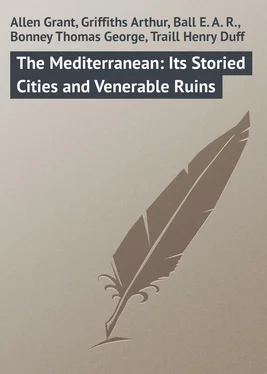E. Ball - The Mediterranean - Its Storied Cities and Venerable Ruins
Здесь есть возможность читать онлайн «E. Ball - The Mediterranean - Its Storied Cities and Venerable Ruins» — ознакомительный отрывок электронной книги совершенно бесплатно, а после прочтения отрывка купить полную версию. В некоторых случаях можно слушать аудио, скачать через торрент в формате fb2 и присутствует краткое содержание. Жанр: Путешествия и география, foreign_prose, foreign_language, на английском языке. Описание произведения, (предисловие) а так же отзывы посетителей доступны на портале библиотеки ЛибКат.
- Название:The Mediterranean: Its Storied Cities and Venerable Ruins
- Автор:
- Жанр:
- Год:неизвестен
- ISBN:нет данных
- Рейтинг книги:3 / 5. Голосов: 1
-
Избранное:Добавить в избранное
- Отзывы:
-
Ваша оценка:
- 60
- 1
- 2
- 3
- 4
- 5
The Mediterranean: Its Storied Cities and Venerable Ruins: краткое содержание, описание и аннотация
Предлагаем к чтению аннотацию, описание, краткое содержание или предисловие (зависит от того, что написал сам автор книги «The Mediterranean: Its Storied Cities and Venerable Ruins»). Если вы не нашли необходимую информацию о книге — напишите в комментариях, мы постараемся отыскать её.
The Mediterranean: Its Storied Cities and Venerable Ruins — читать онлайн ознакомительный отрывок
Ниже представлен текст книги, разбитый по страницам. Система сохранения места последней прочитанной страницы, позволяет с удобством читать онлайн бесплатно книгу «The Mediterranean: Its Storied Cities and Venerable Ruins», без необходимости каждый раз заново искать на чём Вы остановились. Поставьте закладку, и сможете в любой момент перейти на страницу, на которой закончили чтение.
Интервал:
Закладка:
An excursion northwards of the city is necessary, in order to see its charming, fast-increasing suburbs. Many, as is the case with those of Paris, Passy, Auteuil, Belleville, and others, were formerly little towns, but are fast becoming part of Barcelona itself.
Most musically named is Gracia, approached by rail or tramway, where rich citizens have their orange and lemon gardens, their chateaux and villas, and where religious houses abound. In this delightful suburban retreat alone no less than six nunneries may be counted; somber prison-like buildings, with tiny barred windows, indicating the abode of cloistered nuns of ascetic orders. That of the Order of St. Domingo has been recently founded. The house looks precisely like a prison. Here also are several congregations of the other sex – the Missionaries of the Sacred Heart, the Fathers of San Filipe, and others.
Gracia may be called the Hampstead of Barcelona. Hardly a house but possesses its garden. Above the high walls trail gorgeous creepers and datura, whilst through the iron gates we obtain glimpses of dahlias in full splendor, roses red and white, and above these the glossy-leaved orange and lemon trees with their ripening fruit. The pleasantest suburb of Barcelona is well worthy of its name. As Sarria is approached, the scenery becomes more rural, and under the brilliant November sunshine reminds the traveller of the East, the square, white, low-roofed houses rising amid olive and palm trees. The aloes and prickly pears on the waste ground again and again recall Algeria. Here are vast stretches of vegetable gardens and vineyards supplying the city markets, and standing in their own grounds on sunny hill-sides, the quintas or country houses of rich citizens and grandees.
From the little town of Sarria – hardly as yet to be called suburban – a glorious view is obtained of city, port, and sea. The narrow dusty streets, with their close-shuttered houses, have a sleepy look; yet Sarria possesses one of the largest cotton-mills in Spain, several thousand hands being employed by one firm. The branch railway ends at Sarria. Here tourists and holiday-makers alight; the hardy pedestrian to reach the summit of Mont Tibidaho on foot – a matter of two hours or so – the less enterprising, to accept one of the covered cars awaiting excursionists outside the station. Mont Tibidaho is the favorite holiday ground of the citizens. Even in November numerous pleasure parties are sure to be found here, and the large restaurants indicate the extent of summer patronage. On the breezy heights round about are the sumptuous mansions of nobles and merchant princes; whilst down below are numerous picturesque valleys, notably that of San Cugat. The stranger fortunate enough to obtain admission will find himself in the kind of fairyland described by Tennyson in his “Haroun-al-Raschid,” Owen Meredith in “The Siege of Constantinople,” or Gayangos in his delightful translation of the “Chronicles of Al-Makkari.” Marble courts, crystal fountains, magnificent baths, mosaic pavements, statuary, tapestries, aviaries, rare exotics, gold and silver plate, are now combined with all modern appliances of comfort. A sojourn in one of the well-appointed hotels will suffice to give some notion of Spanish society. During the holidays many families from the city take up their quarters here. Social gatherings, picnics, excursions, concerts, are the order of the day, and good military bands enliven the gardens on Sundays.
To the south-east of Barcelona lies the suburb of Barceloneta, frequented by the seafaring population. Penny boats ply between city and suburb, on Sundays and holidays the music of a barrel-organ being thrown into the bargain. The harbor is then black with spectators, and the boats and little steamers, making the cruise of the port for half a franc, are crowded with holiday-makers. The bright silk head-dresses of the women, the men’s crimson or scarlet sombreros and plaids, the uniforms of the soldiers, the gay dresses of the ladies, make up a picturesque scene. On board the boats the music of the barrel-organ must on no account be paid for. A well-intentioned stranger who should offer the musician a penny is given to understand that the treat is gratuitous and generously supplied by the owners of the craft. Greed being almost universal in those parts of the world frequented by tourists, it is gratifying to be able to chronicle such exceptions. Seldom, indeed, has the sightseer at Barcelona to put his hand in his pocket.
If inferior to other Spanish cities in picturesqueness and interest generally, the capital of Catalonia atones for the deficit by its abundance of resources. It possesses nothing to be called a picture-gallery; the museums are second-rate, the collections of antiquities inconsiderable. But what other city in Spain can boast of so many learned bodies and diverse centers of intellectual activity? Excessive devotion and scientific inquiry do not here seem at variance. Strange to say, a population that seems perpetually on its knees is the first to welcome modern ideas.
The Academy of Arts was founded in 1751, and owes its origin to the Junta, or Tribunal of Commerce of Catalonia. This art school is splendidly lodged in the Lonja Palace, and attached to it is a museum, containing a few curious specimens of old Spanish masters, some rather poor copies of the Italian schools, and one real artistic treasure of the first water. This is a collection of studies in black and white by the gifted Fortuny, whose first training was received here. The sketches are masterly, and atone for the insignificance of the remaining collection. Students of both sexes are admitted to the classes, the course of study embracing painting in all its branches, modeling, etching, linear drawing and perspective, anatomy and æsthetics. It is gratifying to find that girls attend these classes, although as yet in small numbers.
The movement in favor of the higher education of women marches at a snail’s pace in Spain. The vast number of convents and what are called “Escuelas Pias,” or religious schools, attest the fact that even in the most cosmopolitan and enlightened Spanish town the education of girls still remains chiefly in the hands of the nuns. Lay schools and colleges exist, also a normal school for the training of female teachers, founded a few years ago. Here and there we find rich families entrusting their girls to English governesses, but such cases are rare.
We must remember, however, that besides the numerous “Escuelas pias” and secular schools, several exist opened under the auspices of the Spanish Evangelical body, and also the League for the Promotion of lay Teaching. We need not infer, then, that because they do not attend the municipal schools the children go untaught.
How reluctantly Catholic countries are won over to educate their women we have witnessed in France. Here in the twentieth century the chief occupation of an educated Spanish lady seems to be that of counting her beads in church.
Music is universally taught, the cultivation of the piano being nowhere more assiduous. Pianoforte teachers may be counted by the hundred; and a Conservatorium, besides academies due to private initiative, offers a thorough musical training to the student. Elegant pianos, characterized by great delicacy of tone and low price, are a leading feature of Barcelona manufacture, notably of the firm Bernareggi.
The University, attended by two thousand five hundred students, was founded so long ago as 1430, and rebuilt in 1873.
A technical school – the only complete school of arts and sciences existing in Spain – was opened under the same roof in 1850; and, in connection with it, night classes are held. Any workman provided with a certificate of good conduct can attend these classes free of cost. Schools of architecture and navigation are also attached to the University.
Читать дальшеИнтервал:
Закладка:
Похожие книги на «The Mediterranean: Its Storied Cities and Venerable Ruins»
Представляем Вашему вниманию похожие книги на «The Mediterranean: Its Storied Cities and Venerable Ruins» списком для выбора. Мы отобрали схожую по названию и смыслу литературу в надежде предоставить читателям больше вариантов отыскать новые, интересные, ещё непрочитанные произведения.
Обсуждение, отзывы о книге «The Mediterranean: Its Storied Cities and Venerable Ruins» и просто собственные мнения читателей. Оставьте ваши комментарии, напишите, что Вы думаете о произведении, его смысле или главных героях. Укажите что конкретно понравилось, а что нет, и почему Вы так считаете.












